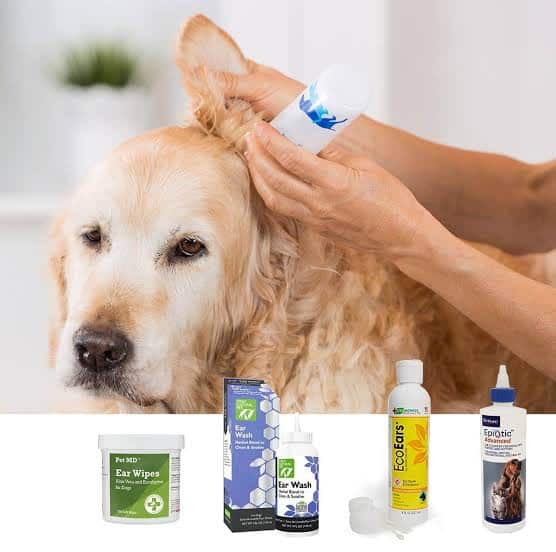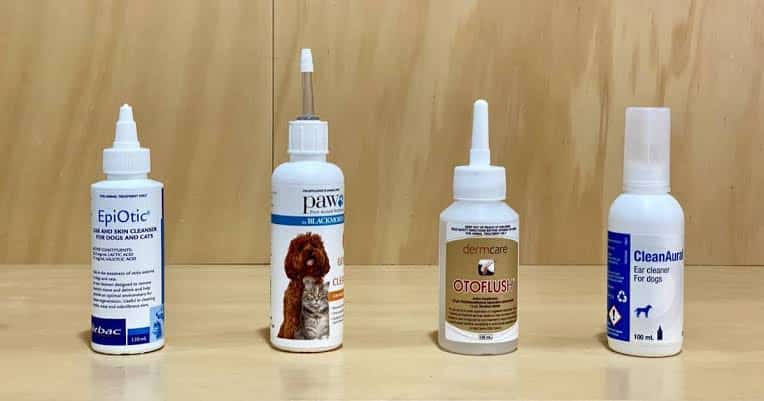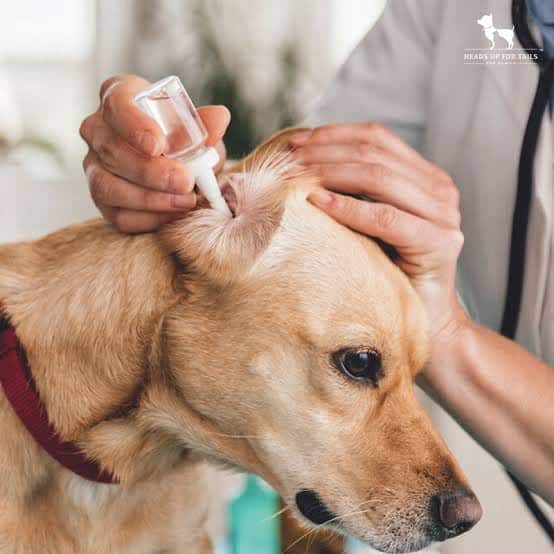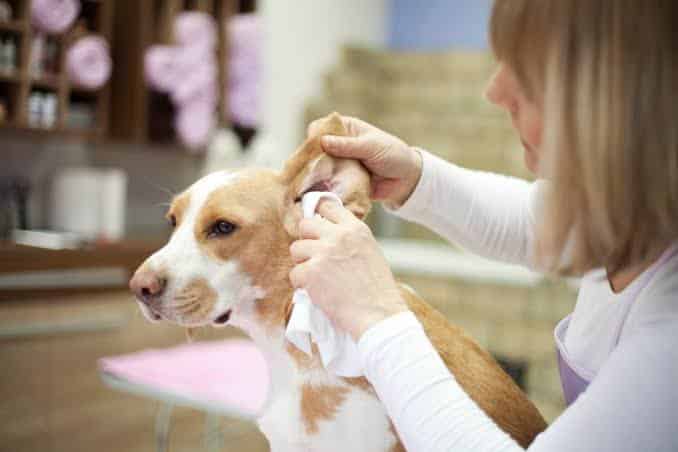Hey there, dog lovers! If you’ve ever dealt with the dreaded dirty dog ears, this is the blog for you. We shall discuss the topic “The Essential Guide To Dog Ear Cleaner”. Also, we shall discuss: The Importance Of Keeping Your Dog’s Ears Clean, What To Look For In A Dog Ear Cleaner, How To Use Dog Ear Cleaner Effectively, Common Mistakes To Avoid When Using Dog Ear Cleaner, etc.
We all know that dogs can have some seriously stinky ears, and keeping them clean is essential for their health and happiness. In this essential guide, we’ll be diving deep into the world of dog ear cleaners – what they are, why they’re important, and which ones are the best. So grab your dog and let’s get started on the path to squeaky clean ears!
The Importance Of Keeping Your Dog’s Ears Clean
Keeping your dog’s ears clean is an essential part of maintaining their overall health and well-being. Regular ear cleaning helps prevent a variety of issues, including ear infections, mites, wax buildup, and foul odors. By taking the time to clean your dog’s ears regularly, you can help ensure their ears remain healthy and comfortable.
When it comes to cleaning your dog’s ears, it’s crucial to use a gentle and non-irritating ear cleaner specifically designed for dogs. Avoid using cotton swabs or other foreign objects, as these can push debris further into the ear canal and potentially cause harm. Instead, use a soft cloth or cotton ball to clean the visible part of the ear, being careful not to go too deep.
Start by inspecting your dog’s ears for any signs of redness, swelling, discharge, or a strong odor. If you notice any of these signs or suspect an ear infection, it’s best to consult your veterinarian for a proper diagnosis and treatment plan.
To clean your dog’s ears, apply a few drops of the ear cleaner into the ear canal and gently massage the base of the ear for about 30 seconds. This will help loosen any debris or wax trapped in the ear canal. Next, use a clean cloth or cotton ball to wipe away any excess cleaner and gently remove any visible debris from the ear. Be sure to be gentle and avoid causing any discomfort to your dog.
It’s important to note that not all dogs will require the same frequency of ear cleaning. Some dogs, such as those with long, floppy ears or a history of ear problems, may require more frequent cleaning. On the other hand, dogs with short, upright ears may need less frequent cleaning. Your veterinarian can provide guidance on how often you should clean your dog’s ears based on their individual needs.
In addition to regular cleaning, it’s essential to keep your dog’s ears dry and free from excessive moisture. Moisture can create a breeding ground for bacteria and increase the risk of ear infections. After bathing your dog or if they have been swimming, it’s a good idea to gently dry their ears with a clean towel or use a pet-safe ear drying solution.
By prioritizing regular ear cleaning and following these guidelines, you can help ensure your dog’s ears stay healthy and free from discomfort. Remember, if you have any concerns or notice any issues with your dog’s ears, it’s always best to consult with your veterinarian for professional advice and proper treatment.

What To Look For In A Dog Ear Cleaner
When it comes to caring for your dog’s ears, it’s important to choose the right ear cleaner. There are many options available on the market, but not all of them are created equal. In this section, we will discuss what you should look for in a dog ear cleaner to ensure that you are providing the best care for your furry friend.
First and foremost, you’ll want to choose an ear cleaner that is specifically formulated for dogs. Human ear cleaners are not suitable for dogs and may cause irritation or other problems. Look for a product that clearly states it is safe for use on dogs.
Next, consider the ingredients in the ear cleaner. Look for a product that contains gentle and natural ingredients. Avoid products that contain harsh chemicals or artificial fragrances, as these can be irritating to your dog’s delicate ears. Ingredients such as aloe vera and tea tree oil can be soothing and help to keep your dog’s ears clean and healthy.
In addition to the ingredients, consider the application method of the ear cleaner. Some products come in a liquid form that can be poured directly into the ear, while others come in pre-soaked pads or wipes. Choose a method that is easy for you to use and comfortable for your dog. Remember, administering ear cleaner should be a stress-free experience for both you and your pet.
Another important factor to consider is the effectiveness of the ear cleaner. Look for a product that is designed to remove dirt, wax, and debris from your dog’s ears. It should help to prevent infections and keep your dog’s ears clean and odor-free. Reading customer reviews and seeking recommendations from your veterinarian can provide valuable insights into the effectiveness of different ear cleaners.
Lastly, consider any additional features or benefits that the ear cleaner may offer. Some products may have additional ingredients that help to prevent ear infections or soothe irritated skin. Others may have a long-lasting effect, reducing the frequency of ear cleanings. Consider your dog’s individual needs and any specific concerns or conditions they may have when choosing an ear cleaner.
In summary, when looking for a dog ear cleaner, choose a product that is specifically formulated for dogs, contains gentle and natural ingredients, is easy to apply, is effective at removing dirt and debris, and offers any additional features that may benefit your dog’s specific needs. By selecting the right ear cleaner, you can help ensure that your dog’s ears are healthy, clean, and free from irritation.
How To Use Dog Ear Cleaner Effectively
Using dog ear cleaner is an important part of maintaining your dog’s overall health and well-being. But it’s not enough to simply apply the cleaner and hope for the best. To get the best results and ensure the safety of your furry friend, it’s important to know how to use dog ear cleaner effectively.
First and foremost, it’s crucial to choose the right type of dog ear cleaner for your pet. There are several different options available, including solutions, wipes, and drops. Consult with your veterinarian to determine which type is best suited for your dog’s individual needs. Once you have the right product, follow these steps to effectively clean your dog’s ears.
Start by carefully reading the instructions provided by the manufacturer. Each product may have specific directions for use, so it’s important to familiarize yourself with them before getting started. Gather all the necessary supplies, such as cotton balls or pads, gloves, and a towel.
Next, prepare your dog for the cleaning process. Finding a calm and quiet environment will help reduce any stress or anxiety your dog may experience. It can also be helpful to have treats or a favorite toy on hand to reward and distract your dog during the process.
Before applying the cleaner, gently inspect your dog’s ear for any signs of redness, swelling, discharge, or odor. If you notice anything unusual or if your dog shows signs of discomfort, it’s best to consult with your veterinarian before proceeding with the cleaning.
Once you’re ready to begin, carefully lift your dog’s ear flap and hold it gently. Apply the recommended amount of ear cleaner into the ear canal. Be sure to follow the instructions provided by the manufacturer to ensure you’re using the correct amount. Avoid inserting the applicator too deep into the ear canal, as this can cause injury.
After applying the cleaner, gently massage the base of the ear for about 30 seconds. This will help distribute the cleaner throughout the ear and loosen any debris or wax. You may hear a squishing sound, which is normal.
Finally, use a clean cotton ball or pad to gently wipe away any excess cleaner, debris, or wax that may have been loosened. Be careful not to insert anything into the ear canal, as this can damage your dog’s delicate ear structures. Repeat the process with the other ear, if necessary.
It’s important to note that not all dogs will tolerate having their ears cleaned, especially if they have had previous negative experiences or underlying ear issues. If your dog becomes overly anxious or aggressive during the cleaning process, it’s best to consult with your veterinarian for alternative solutions or professional assistance.
Regular ear cleanings are important for preventing ear infections and maintaining your dog’s ear health. However, it’s essential to use dog ear cleaner effectively and to consult with your veterinarian if you have any concerns or questions. With proper care and attention, you can help keep your dog’s ears clean and free from discomfort.

Common Mistakes To Avoid When Using Dog Ear Cleaner
Using dog ear cleaner is an important part of maintaining your pet’s health and hygiene. However, there are some common mistakes that pet owners make when using dog ear cleaner that can lead to ineffective cleaning or even injury. In this section, we will discuss some of the most common mistakes to avoid when using dog ear cleaner and provide tips on how to use it properly.
One of the most common mistakes is not properly inspecting your dog’s ears before applying the cleaner. It is important to visually examine your dog’s ears for any signs of infection or injury before proceeding with the cleaning process. If you notice any redness, swelling, discharge, or a foul odor coming from your dog’s ears, it is best to consult with a veterinarian before attempting to clean them yourself.
Another common mistake is using the wrong type of dog ear cleaner. There are different types of ear cleaners available, including solutions, wipes, and drops. It is important to choose a product that is specifically designed for dogs and not use any human ear cleaners as they can be harmful to your pet. Always follow the instructions provided by the manufacturer and consult with your veterinarian for recommendations on which product to use.
Improper application of the dog ear cleaner is also a common mistake. It is important to follow the instructions provided by the manufacturer and use the recommended amount of cleaner for your dog’s size. Using too much cleaner can cause discomfort or irritation, while using too little may not effectively clean the ears. Gently massage the base of your dog’s ears after applying the cleaner to help distribute it evenly and loosen any debris or wax buildup.
One mistake that can lead to injury is using improper tools for cleaning your dog’s ears. Avoid using cotton swabs or any sharp instruments as they can damage the delicate structures of the ear or push debris further into the ear canal. Instead, use a soft, clean cloth or absorbent pad to wipe the inside of the ear, being careful not to insert it too far into the ear canal.
Lastly, forgetting to follow up with proper ear drying is a common mistake. After cleaning your dog’s ears, it is important to allow them to dry thoroughly. Moisture trapped in the ear canal can create a breeding ground for bacteria and lead to ear infections. Use a clean cloth or towel to gently dry the outer part of the ear and encourage your dog to shake their head to remove any excess moisture.
By avoiding these common mistakes and following proper techniques, you can ensure that your dog’s ears are clean and healthy. If you have any concerns or are unsure about how to properly clean your dog’s ears, it is always best to consult with a veterinarian for guidance and assistance.

Exploring Natural And Homemade Alternatives
When it comes to finding alternatives to store-bought products, many people are turning to natural and homemade options. Whether it’s for health reasons, a desire to reduce waste, or simply a preference for more sustainable choices, there is a growing interest in finding alternative solutions.
One area where natural and homemade alternatives have gained popularity is personal care products. Many individuals are opting for homemade skincare and haircare products, using natural ingredients such as coconut oil, shea butter, and essential oils. These homemade alternatives can often be more affordable and customizable than their commercial counterparts, allowing individuals to cater to their specific needs and preferences.
In addition to personal care products, natural and homemade alternatives can also extend to cleaning products. Traditional cleaning products often contain harsh chemicals that can be harmful to both the environment and our health. Homemade cleaning solutions, on the other hand, can be made using simple ingredients like vinegar, baking soda, and lemon juice. These alternatives are not only more eco-friendly but can also be just as effective in keeping our homes clean and germ-free.
Furthermore, natural and homemade alternatives can also be found in the realm of food and beverages. Many individuals are opting to make their own condiments, nut milk, and even fermented food like kimchi or sauerkraut. By doing so, they have better control over the ingredients used, ensuring that they are free from additives and preservatives. Additionally, homemade alternatives can also be a great way to reduce food waste, as they often utilize ingredients that might otherwise have been discarded.
While natural and homemade alternatives may require more effort and preparation, many find the benefits outweigh the additional work. Whether it’s the satisfaction of knowing exactly what goes into the products we use or the sense of self-sufficiency and creativity that comes from DIY solutions, exploring natural and homemade alternatives can open up a whole new world of possibilities for those seeking a more sustainable and mindful lifestyle.

The Benefits Of Regular Ear Cleaning For Dogs
By keeping your dog’s ears clean and free from debris, you can prevent a variety of ear-related issues and ensure their comfort.
One of the main benefits of regular ear cleaning is the prevention of ear infections. Dogs, especially those with floppy ears, are prone to developing infections due to the build-up of wax, dirt, and moisture in their ear canals. By gently cleaning the ears on a regular basis, you can remove these potential irritants and reduce the risk of infections.
Cleaning your dog’s ears can also help you detect any early signs of infection or other health issues. During the cleaning process, you may notice redness, swelling, or discharge, which are common indicators of an underlying problem. By catching these issues early on, you can seek veterinary attention promptly and prevent them from worsening.
Additionally, regular ear cleaning can reduce the occurrence of ear mites, a common parasite that can cause discomfort and irritation in dogs. These tiny insects thrive in dark and moist environments, making a dog’s ears an ideal breeding ground. By cleaning your dog’s ears, you can remove any mites and prevent their population from multiplying.
Proper ear cleaning can also improve your dog’s overall comfort and well-being. A build-up of wax and debris can cause itching and discomfort, leading to excessive scratching or head shaking. Regular cleaning can eliminate these irritants and help your dog feel more comfortable.
It’s important to note that not all dogs require the same frequency of ear cleaning. Some dogs with healthy ears may only need cleaning once a month, while others with a history of ear issues may need more frequent cleanings. Consult with your veterinarian to determine the right ear cleaning schedule for your dog’s specific needs.
In conclusion, regular ear cleaning offers several benefits for your dog, including the prevention of infections, identification of underlying health issues, reduction of ear mites, and improved comfort. By making ear cleaning a part of your dog’s grooming routine, you can contribute to their overall health and happiness.
Taking Preventative Measures For Optimal Dog Ear Health
Dog ears are susceptible to various issues, but with proactive measures, we can create a harmonious and healthy soundscape for our canine companions.
1. Regular Inspections
Begin your journey toward optimal dog ear health by incorporating regular ear inspections into your routine. Gently examine the ears for redness, swelling, or any signs of discomfort. Catching issues early is key to preventing complications.
2. Understanding Canine Ear Anatomy
To effectively care for your dog’s ears, it’s essential to grasp the basics of their ear anatomy. Dogs have a vertical ear canal, making them prone to ear issues such as infections, wax buildup, and mites. Familiarizing yourself with your pup’s unique ear structure is the first step in preventative care.
3. Mind The Fur
Some breeds are more prone to ear issues due to their floppy ears or excessive hair growth. Trim excess hair around the ear canal to promote air circulation and reduce the likelihood of infections.
4. Swimming Safely
If your pup loves water activities, be mindful of their ears. Moisture in the ears can lead to infections. After swimming, gently dry the ears with a clean cloth. Consider using canine-specific ear protection if your dog is a frequent swimmer.
5. Regular Vet Check-ups
Include ear examinations in your dog’s routine veterinary visits. A professional can identify potential problems early on, offer advice on preventative measures, and recommend suitable ear care products.
6. Healthy Diet, Healthy Ears
Nutrition plays a vital role in overall canine health, including ear health. A well-balanced diet supports the immune system, helping the body fend off potential infections. Consult with your vet to ensure your dog’s diet aligns with their specific health needs.
7. Insect Vigilance
Insects can be more than just a nuisance – they can introduce irritants to your dog’s ears. During outdoor activities, particularly in warmer months, use appropriate insect repellents to ward off potential pests.
8. Prompt Action For Discomfort
If your dog displays signs of discomfort such as scratching at the ears, head shaking, or unusual odor, consult your vet promptly. Early intervention can prevent minor issues from escalating into more serious conditions.
FAQs
1. What is the importance of using a dog ear cleaner?
Regular use of a dog ear cleaner helps prevent ear infections, removes wax buildup, and promotes overall ear health in your canine companion.
2. How often should I clean my dog’s ears?
Frequency depends on your dog’s breed, activity level, and individual ear health. As a general guideline, monthly cleanings are a good starting point, but consult your vet for personalized advice.
3. Can I use human ear cleaners on my dog?
No, it’s recommended to use specially formulated dog ear cleaners. Human products may contain ingredients harmful to dogs or disrupt their ear pH balance.
4. How do I clean my dog’s ears safely?
Apply the cleaner as directed, gently massage the base of the ear, and allow your dog to shake its head. Wipe away visible debris with a cotton ball. Never insert anything deep into the ear canal.
5. Are there specific ear cleaners for different breeds?
Some breeds are more prone to ear issues. Consult your vet for recommendations tailored to your dog’s breed and individual needs.
6. My dog’s ears smell bad. Is that normal?
Foul odor can indicate an infection. Consult your vet promptly for a proper diagnosis and treatment plan.
7. Can I make a homemade dog ear cleaner
Homemade solutions may not have the right pH balance. It’s safer to use vet-approved commercial cleaners to avoid potential irritation or complications.
8. Can ear cleaning prevent ear infections?
Regular cleaning can help prevent infections, but it’s not a guarantee. If you notice signs of infection (redness, swelling, discharge), consult your vet.
9. What if my dog resists ear cleaning?
Take it slow, use positive reinforcement, and make the experience enjoyable with treats. If resistance persists, consult your vet for professional assistance.
Conclusion
“The Essential Guide To Dog Ear Cleaner”, serves as a valuable resource for pet owners, offering comprehensive information on maintaining canine ear health. By providing insights into proper cleaning techniques, product recommendations, and potential issues to watch for, this guide empowers dog owners to proactively care for their pets’ ears, fostering a healthier and happier relationship between humans and their canine companions.
